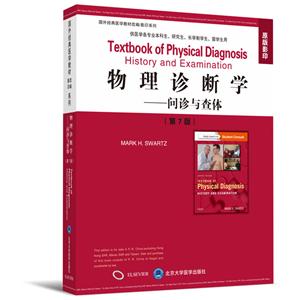SECTION 1 The Art of Interviewing
CHAPTER 1 The Interviewer's Questions
Basic Principles
Using an interpreter
Important Interviewing Concepts
Symptoms and Signs
Conducting an Interview
Basic Interviewing Techniques
Format of the History
Taking Notes
Concluding Thoughts
CHAPTER 2 The Patient's Responses
Responses to Illness
Responses to the Interviewer
Influence of Background and Age on Patient Response
Influence of Disease on Patient Response
CHAPTER 3 Putting the History Together
Interview of Mr. John Doe
Written History of Mr. John Doe
SECTION 2 The Science of the Physical Examination
CHAPTER 4 The Physical Examination
The Basic Procedures
Preparation for the Examination
Health Care Infection Control Practices
Goal of the Physical Examination
CHAPTER 5 The Skin
General Considerations
Structure and Physiologic Characteristics
Review of Specific Symptoms
Effect of Skin Disease on the Patient
Physical Examination
Description of Lesions
Clinicopathologic Correlations
CHAPTER 6 The Head and Neck
General Considerations
Structure and Physiology
Effect of Head and Neck Disease on the Patient
Physical Examination
Clinicopathologic Correlations
CHAPTER 7 The Eye
Historical Considerations
Structure and Physiology
Review of Specific Symptoms
Effect of Blindness on the Patient
Physical Examination
Clinicopathologic Correlations
CHAPTER 8 The Ear and Nose
General Considerations
Structure and Physiology
Review of Specific Symptoms
Effect of Deafness on the Patient
Physical Examination
Clinicopathologic Correlations
CHAPTER 9 The Oral Cavity and Pharynx
General Considerations
Structure and Physiologic Characteristics
The Pharynx
Review of Specific Symptoms
Effect of a Voice Disorder on the Patient
Physical Examination
Clinicopathologic Correlations
CHAPTER 10 The Chest
General Considerations
Structure and Physiology
Review of Specific Symptoms
Effect of Lung Disease on the Patient
Physical Examination
Clinicopathologic Correlations
CHAPTER 11 The Heart
General Considerations
Structure and Physiology
Review of Specific Symptoms
Effect of Cardiac Disease on the Patient
Physical Examination
Clinicopathologic Correlations
CHAPTER 12 The Peripheral Vascular System
General Considerations
Structure and Physiology
Review of Specific Symptoms
Effect of Vascular Disease on the Patient
Physical Examination
Clinicopathologic Correlations
CHAPTER 13 The Breast
General Considerations
Structure and Physiology
Review of Specific Symptoms
Impact of Breast Disease on the Woman
Physical Examination
The Male Breast
Clinicopathologic Correlations
CHAPTER 14 The Abdomen
General Considerations
Structure and Physiology
Review of Specific Symptoms
Impact of Inflammatory Bowel Disease on the Patient
Physical Examination
Clinicopathologic Correlations
CHAPTER 15 Male Genitalia and Hernias
General Considerations
Structure and Physiologic Characteristics
Review of Specific Symptoms
Impact of Erectile Dysfunction on the Man
Physical Examination
Clinicopathologic Correlations
CHAPTER 16 Female Genitalia
General Considerations
Structure and Physiologic Characteristics
Review of Specific Symptoms
Effect of Infertility on the Woman
Physical Examination
Preparation for the Examination
Clinicopathologic Correlations
CHAPTER 17 The Musculoskeletal System
General Considerations
Structure and Physiology
Review of Specific Symptoms
Effect of Musculoskeletal Disease on the Patient
Physical Examination
Clinicopathologic Correlations
CHAPTER 18 The Nervous System
General Considerations
Structure and Physiologic Characteristics
Review of Specific Symptoms
Effect of Chronic Neurologic Disease on the Patient
Physical Examination
Clinicopathologic Correlations
CHAPTER 19 Putting the Examination Together
The Techniques
The Written Physical Examination
SECTION 3 Evaluation of Specific Patients
CHAPTER 20 The Pregnant Patient
General Considerations
Structure and Physiologic Characteristics
Review of Specific Systems
Obstetric Risk Assessment
Calculation of Due Date
Effect of Pregnancy on the Patient
Physical Examination
Clinicopathologic Correlations
CHAPTER 21 The Pediatric Patient
General Considerations
The Pediatric History
Examination of the Newborn
Examination of the Infant
Review of Systems and Examination of the Young Child
Review of Systems and Examination of the Older Child
Review of Systems and Examination of the Adolescent
Clinicopathologic Correlations
CHAPTER 22 The Geriatric Patient
General Considerations
Structure and Physiologic Characteristics
Basic Principles of Geriatric Medicine
The Geriatric History
Effect of Growing Old on the Patient
Physical Examination
Clinicopathologic Correlations
CHAPTER 23 The Acutely III or Injured Patient
Personal Safety
Current Cardiopulmonary Resuscitation Guidelines
C-A-B
Cardiopulmonary Resuscitation Survey
Summary of CPR Guidelines for Adults, Children, and Infants
Assessment of the Acutely III or Injured Patient
The Pediatric Emergency
SECTION 4 Putting the Data to Work
CHAPTER 24 Diagnostic Reasoning in Physical Diagnosis
Art, Science, and Observation
Diagnostic Reasoning from Signs and Symptoms
CHAPTER 25 The Clinical Record
Putting the History and Physical Examination Together
The Human Dimension
CHAPTER 26 The Focused History and Physical Examination*
General Considerations
Illustrative Case
Diagnostic Evaluation
SECTION 5 Special Additional ImportantTopics (Internet-Based)
CHAPTER 27 Caring for Patients in a Culturally Diverse Society*
General Considerations
Specific Cross-Cultural Perspectives
Concluding Thoughts
CHAPTER 28 Understanding Complementary and Alternative Medicine*
General Considerations
Classifications of Complementary and Alternative Medicine
Traditional Chinese Medicine
Concluding Thoughts
CHAPTER 29 Assessment of Nutritional Status*
Medical History
Physical Examination
Special Populations
Clinicopathologic Correlations
Concluding Thoughts
Epilogue*
Ethical Challenges
Unethical Labeling of Patients
Health Care Proxy
Concluding Thoughts
APPENDIX A Commonly Abused Drugs*
APPENDIX B Signs and Symptoms of Deficiency States*
APPENDIX C Conversion Tables*
APPENDIX D The Rational Clinical Examination: Additional References*
APPENDIX E Advisory Committee on Immunization Practices (ACIP)
Recommended Immunization Schedule for Adults Aged 19
Years and OldermUnited States, 2013*
APPENDIX F Advisory Committee on Immunizatior/Practices (ACIP)
Recommended Immunization Schedule for Persons Aged
0 Through 18 YearsmUnited States, 2013*
Index




















